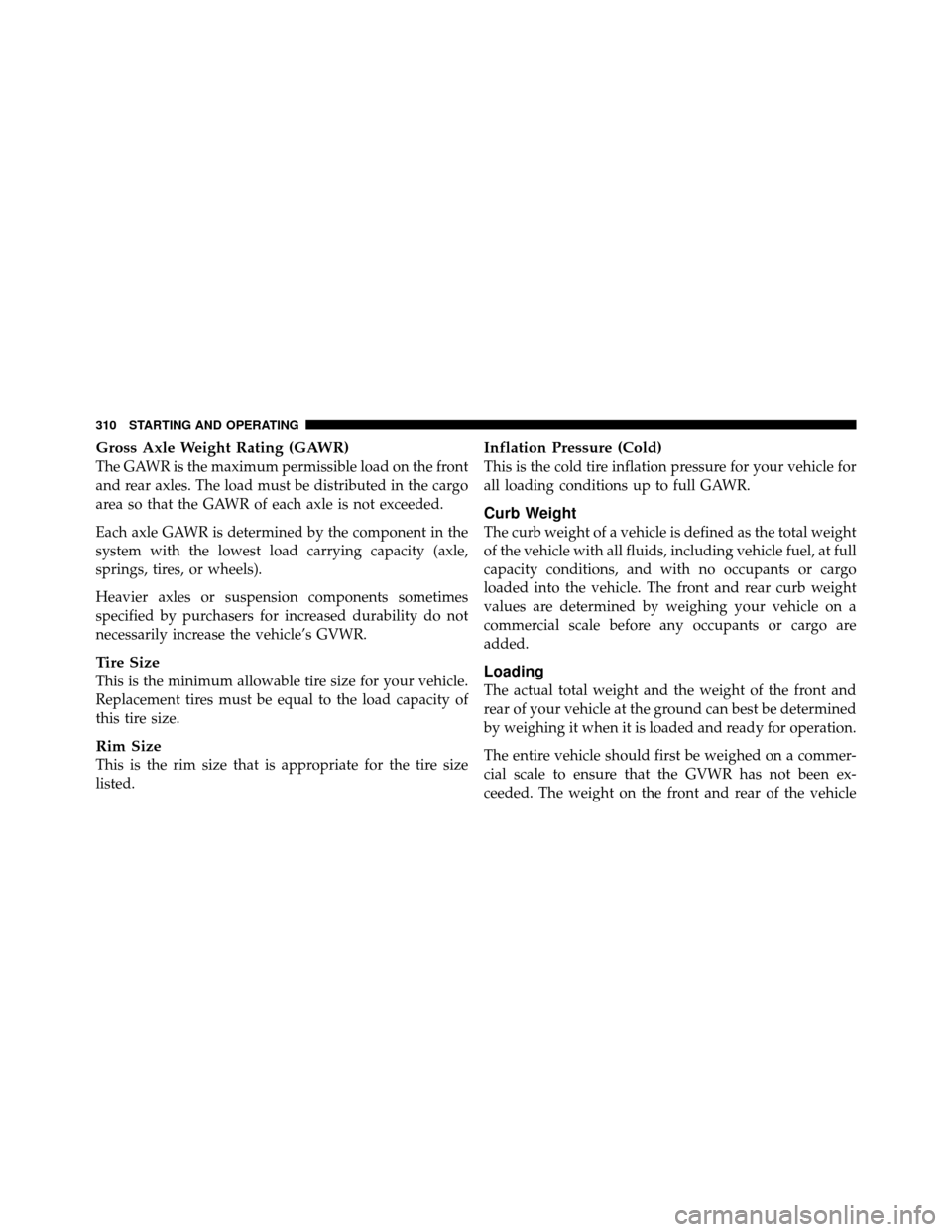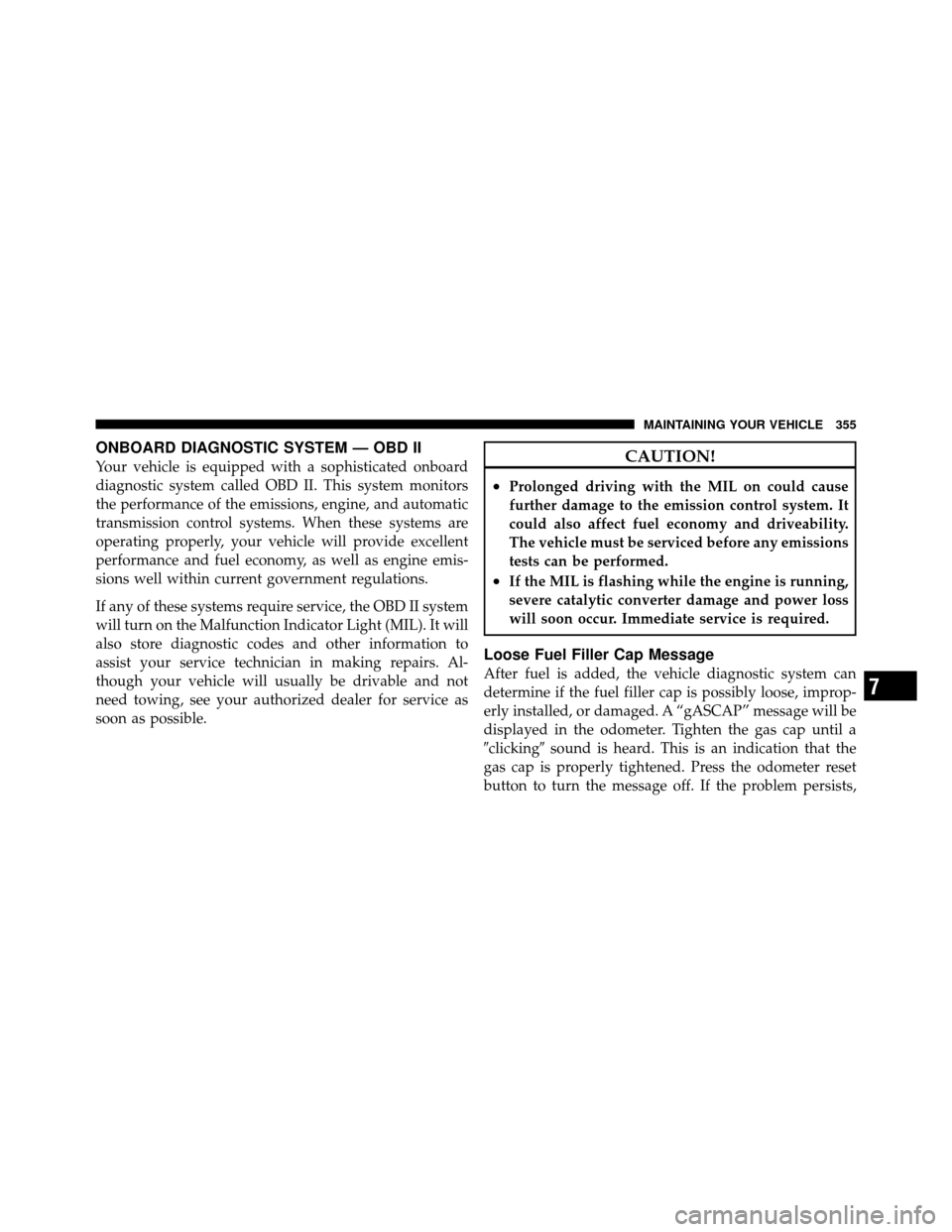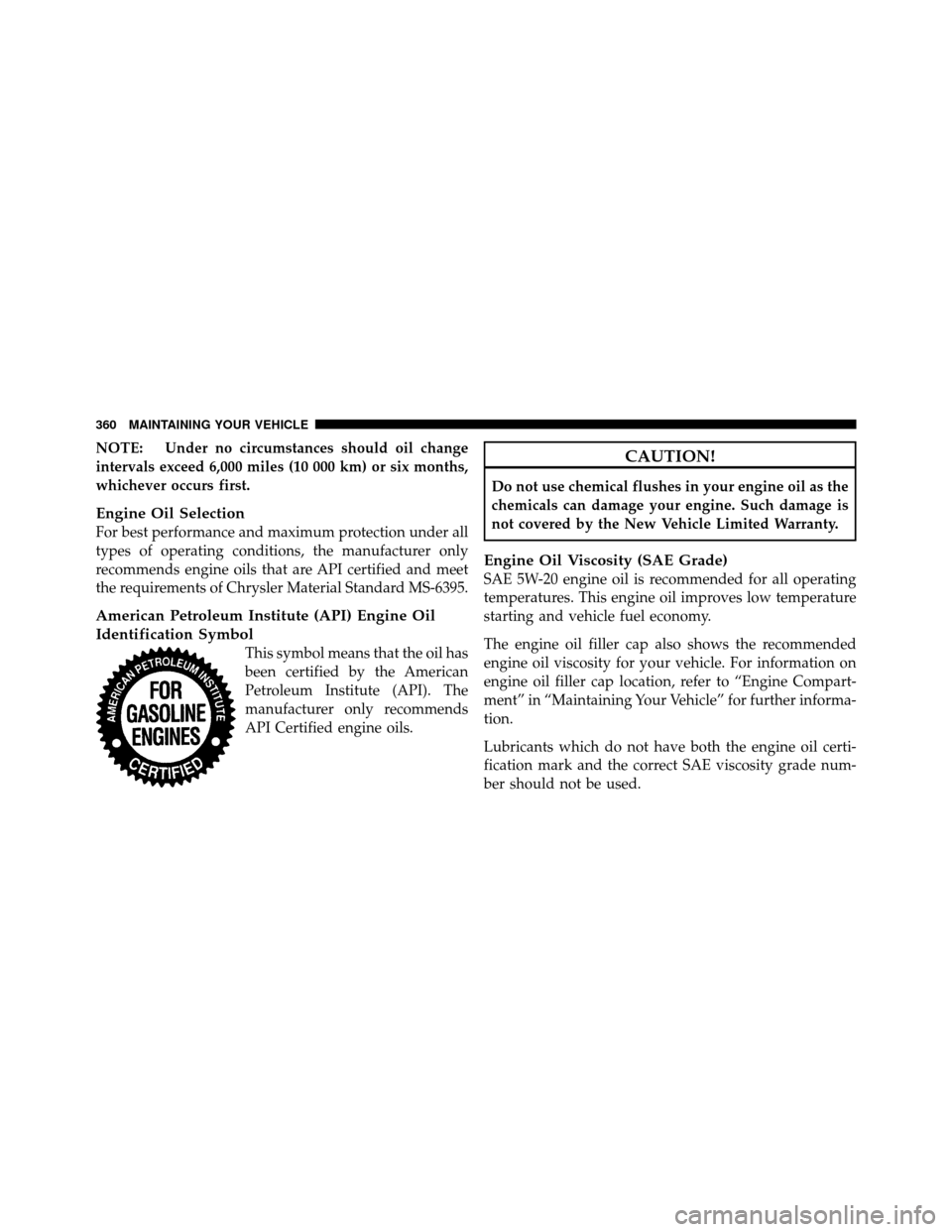Page 308 of 450
ADDING FUEL
Fuel Filler Cap (Gas Cap)
The gas cap is located behind the fuel filler door. When
fueling, the cap may be placed on the inside of the filler
door.If the gas cap is lost or damaged, be sure the replacement
cap is for use with this vehicle.CAUTION!
•Damage to the fuel system or emissions control
system could result from using an improper fuel
tank filler tube cap (gas cap). A poorly fitting cap
could let impurities into the fuel system.
•To avoid fuel spillage and overfilling, do not “top
off” the fuel tank after filling.
WARNING!
•Never allow any lit smoking materials near the
vehicle while removing the cap or filling the tank.
(Continued)
Gas Cap Holder
5
STARTING AND OPERATING 307
Page 309 of 450

WARNING! (Continued)
•Never add fuel to the vehicle when the engine is
running. This is in violation of most state and
federal regulations and will cause the “Malfunc-
tion Indicator Light (MIL)” to turn on.
•A fire may result if gasoline is pumped into a
portable container that is inside of a vehicle or on
a truck bed. You could be burned. Always place
gas containers on the ground while filling.
NOTE:
•If fuel is poured from a portable container, the con-
tainer should have a flexible nozzle long enough to
extend into the fuel filler tube.
•When the fuel nozzle “clicks” or shuts off, the fuel
tank is full.
•Tighten the gas cap until you hear a “clicking” sound.
This is an indication that the gas cap is properly
tightened. Make sure that the gas cap is tightened each
time the vehicle is refueled.
Loose Fuel Filler Cap Message
After fuel has been added, the vehicle diagnostic system
can determine if the fuel filler cap is possibly loose,
improperly installed, or damaged. If the system detects a
malfunction, the “gASCAP” message will display in the
odometer display. Tighten the gas cap until a �clicking�
sound is heard. This is an indication that the gas cap is
properly tightened. Press the odometer reset button to
turn the message off. If the problem persists, the message
will appear the next time the vehicle is started. This
might indicate a damaged cap. If the problem is detected
twice in a row, the system will turn on the MIL. Resolving
the problem will turn the MIL off.
308 STARTING AND OPERATING
Page 311 of 450

Gross Axle Weight Rating (GAWR)
The GAWR is the maximum permissible load on the front
and rear axles. The load must be distributed in the cargo
area so that the GAWR of each axle is not exceeded.
Each axle GAWR is determined by the component in the
system with the lowest load carrying capacity (axle,
springs, tires, or wheels).
Heavier axles or suspension components sometimes
specified by purchasers for increased durability do not
necessarily increase the vehicle’s GVWR.
Tire Size
This is the minimum allowable tire size for your vehicle.
Replacement tires must be equal to the load capacity of
this tire size.
Rim Size
This is the rim size that is appropriate for the tire size
listed.
Inflation Pressure (Cold)
This is the cold tire inflation pressure for your vehicle for
all loading conditions up to full GAWR.
Curb Weight
The curb weight of a vehicle is defined as the total weight
of the vehicle with all fluids, including vehicle fuel, at full
capacity conditions, and with no occupants or cargo
loaded into the vehicle. The front and rear curb weight
values are determined by weighing your vehicle on a
commercial scale before any occupants or cargo are
added.
Loading
The actual total weight and the weight of the front and
rear of your vehicle at the ground can best be determined
by weighing it when it is loaded and ready for operation.
The entire vehicle should first be weighed on a commer-
cial scale to ensure that the GVWR has not been ex-
ceeded. The weight on the front and rear of the vehicle
310 STARTING AND OPERATING
Page 352 of 450
MAINTAINING YOUR VEHICLE
CONTENTS
�Engine Compartment — 3.7L ............. 353
� Engine Compartment — 4.7L ............. 354
� Onboard Diagnostic System — OBD II ...... 355
▫ Loose Fuel Filler Cap Message ........... 355
� Emissions Inspection And Maintenance
Programs ............................ 356
� Replacement Parts ..................... 357
� Dealer Service ........................ 358
� Maintenance Procedures ................. 358 ▫
Engine Oil ......................... 359
▫ Engine Oil Filter ..................... 361
▫ Engine Air Cleaner Filter ............... 362
▫ Maintenance-Free Battery .............. 362
▫ Air Conditioner Maintenance ............ 363
▫ Body Lubrication .................... 364
▫ Windshield Wiper Blades ............... 365
▫ Adding Washer Fluid ................. 365
7
Page 356 of 450

ONBOARD DIAGNOSTIC SYSTEM — OBD II
Your vehicle is equipped with a sophisticated onboard
diagnostic system called OBD II. This system monitors
the performance of the emissions, engine, and automatic
transmission control systems. When these systems are
operating properly, your vehicle will provide excellent
performance and fuel economy, as well as engine emis-
sions well within current government regulations.
If any of these systems require service, the OBD II system
will turn on the Malfunction Indicator Light (MIL). It will
also store diagnostic codes and other information to
assist your service technician in making repairs. Al-
though your vehicle will usually be drivable and not
need towing, see your authorized dealer for service as
soon as possible.CAUTION!
•Prolonged driving with the MIL on could cause
further damage to the emission control system. It
could also affect fuel economy and driveability.
The vehicle must be serviced before any emissions
tests can be performed.
•If the MIL is flashing while the engine is running,
severe catalytic converter damage and power loss
will soon occur. Immediate service is required.
Loose Fuel Filler Cap Message
After fuel is added, the vehicle diagnostic system can
determine if the fuel filler cap is possibly loose, improp-
erly installed, or damaged. A “gASCAP” message will be
displayed in the odometer. Tighten the gas cap until a
�clicking�sound is heard. This is an indication that the
gas cap is properly tightened. Press the odometer reset
button to turn the message off. If the problem persists,
7
MAINTAINING YOUR VEHICLE 355
Page 361 of 450

NOTE: Under no circumstances should oil change
intervals exceed 6,000 miles (10 000 km) or six months,
whichever occurs first.
Engine Oil Selection
For best performance and maximum protection under all
types of operating conditions, the manufacturer only
recommends engine oils that are API certified and meet
the requirements of Chrysler Material Standard MS-6395.
American Petroleum Institute (API) Engine Oil
Identification Symbol
This symbol means that the oil has
been certified by the American
Petroleum Institute (API). The
manufacturer only recommends
API Certified engine oils.
CAUTION!
Do not use chemical flushes in your engine oil as the
chemicals can damage your engine. Such damage is
not covered by the New Vehicle Limited Warranty.
Engine Oil Viscosity (SAE Grade)
SAE 5W-20 engine oil is recommended for all operating
temperatures. This engine oil improves low temperature
starting and vehicle fuel economy.
The engine oil filler cap also shows the recommended
engine oil viscosity for your vehicle. For information on
engine oil filler cap location, refer to “Engine Compart-
ment” in “Maintaining Your Vehicle” for further informa-
tion.
Lubricants which do not have both the engine oil certi-
fication mark and the correct SAE viscosity grade num-
ber should not be used.
360 MAINTAINING YOUR VEHICLE
Page 400 of 450
Fog Lamps
1. Disconnect connector from the fog lamp by raising the
wire harness lock tab and pulling on wire harness
connector.2. Rotate the bulb 1/4-turn counterclockwise and pull to
remove from the fog lamp housing.
3. Reverse procedure to install.
FLUID CAPACITIES
U.S.
Metric
Fuel (Approximate) 22 Gallons83 Liters
Engine Oil with Filter
3.7L Engine (SAE 5W-20, API Certified) 5 Quarts4.7 Liters
4.7L Engine (SAE 5W-20, API Certified) 6 Quarts5.7 Liters
Cooling System (Includes 2.1 Quarts/2 Liters for
Coolant Bottle)
3.7L Engine (MOPAR� Antifreeze/Coolant 5
Year/100,000 Mile Formula or equivalent) 13.3 Quarts
12.5 Liters
4.7L Engine (MOPAR� Antifreeze/Coolant 5
Year/100,000 Mile Formula or equivalent) 13.3 Quarts
12.5 Liters
7
MAINTAINING YOUR VEHICLE 399
Page 401 of 450
FLUIDS, LUBRICANTS AND GENUINE PARTS
Engine
ComponentFluid, Lubricant, or Genuine Part
Engine Coolant MOPAR�Antifreeze/Coolant 5 Year/100,000 Mile Formula HOAT (Hy-
brid Organic Additive Technology) or equivalent.
Engine Oil Use API Certified SAE 5W-20 Engine Oil, meeting the requirements of
Chrysler Material Standard MS-6395. Refer to your engine oil filler cap
for correct SAE grade.
Engine Oil Filter MOPAR�Engine Oil Filter or equivalent.
Spark Plugs – 3.7L Engine ZFR6F-11G (Gap 0.043 in [1.09 mm])
Spark Plugs – 4.7L Engine Upper Bank — FR8TE2 (Gap 0.039 in [0.99 mm]) Lower Bank —
FR8T1332 (Gap 0.051 in [1.30 mm])
Fuel Selection 87 Octane
400 MAINTAINING YOUR VEHICLE